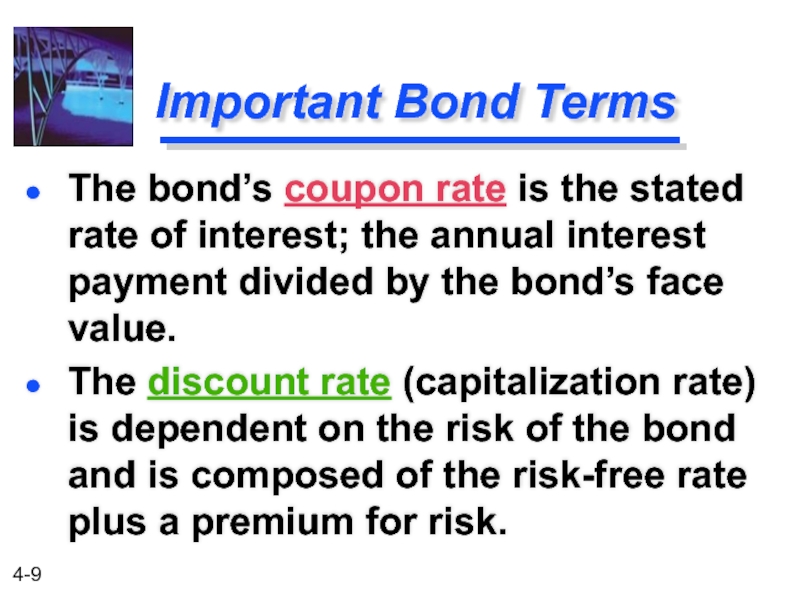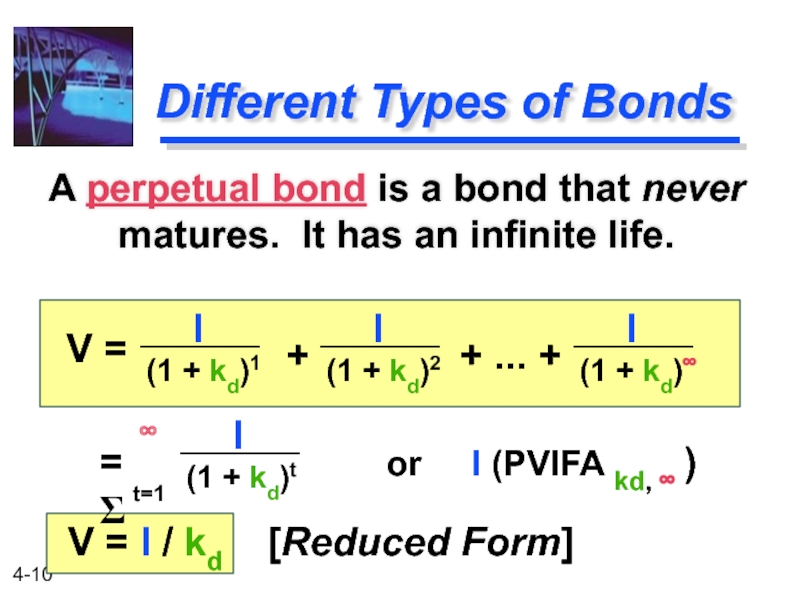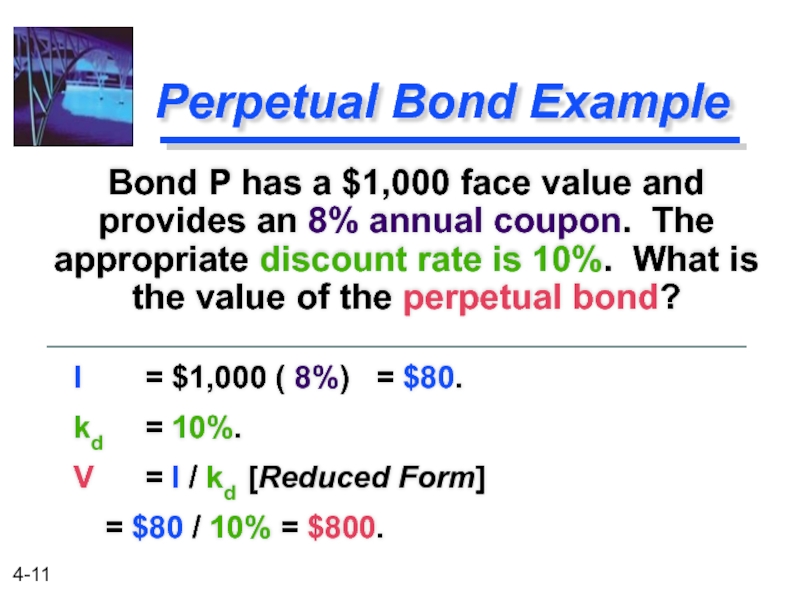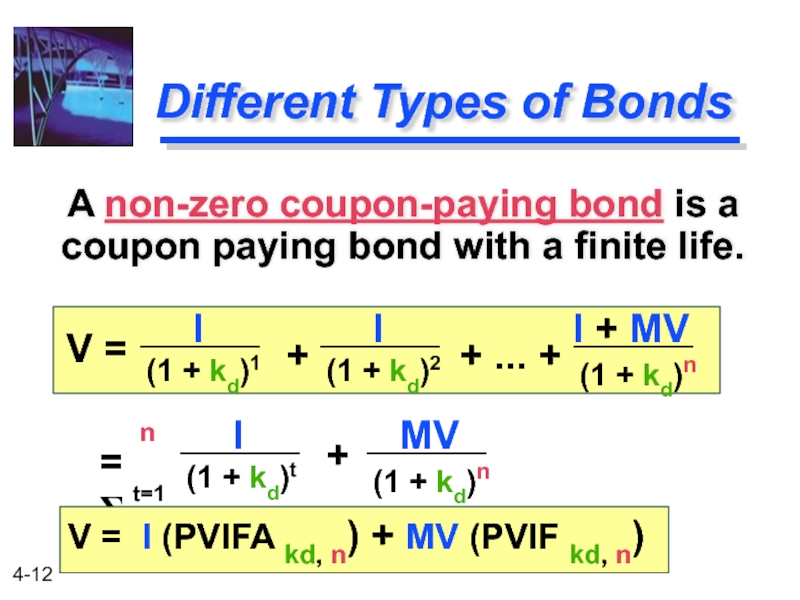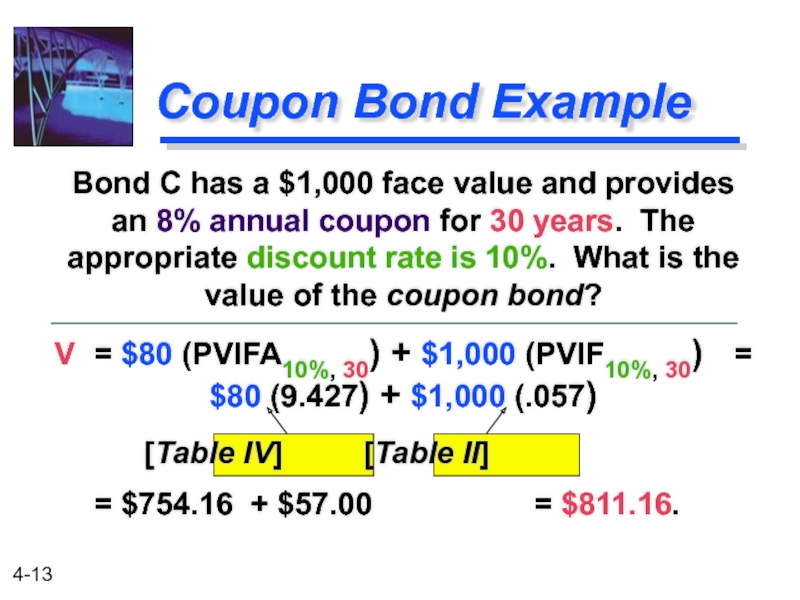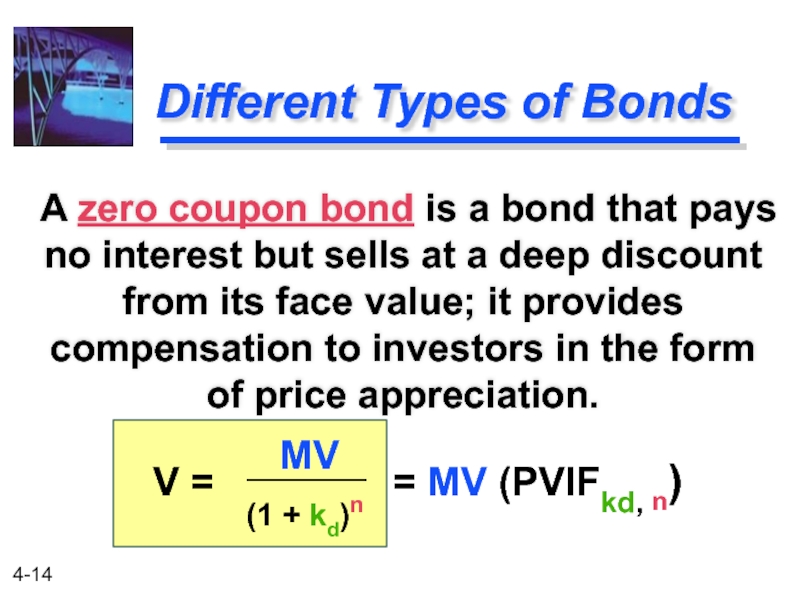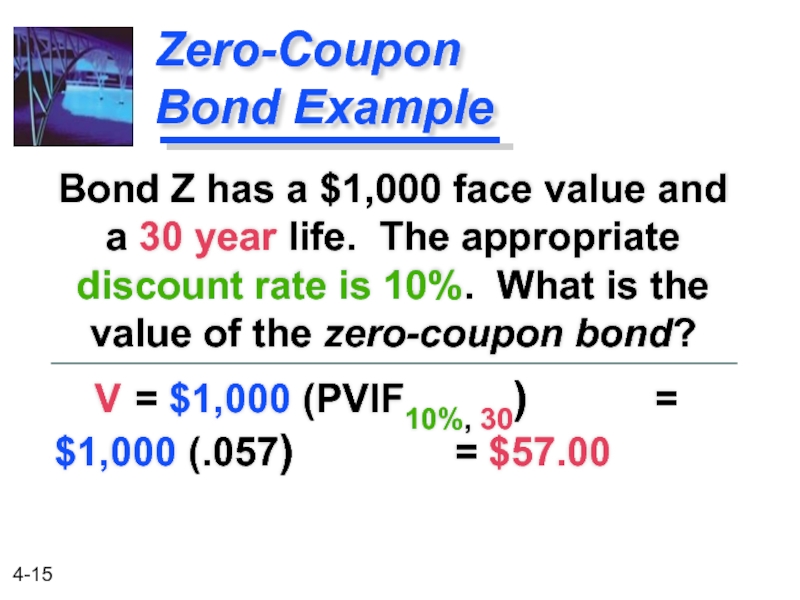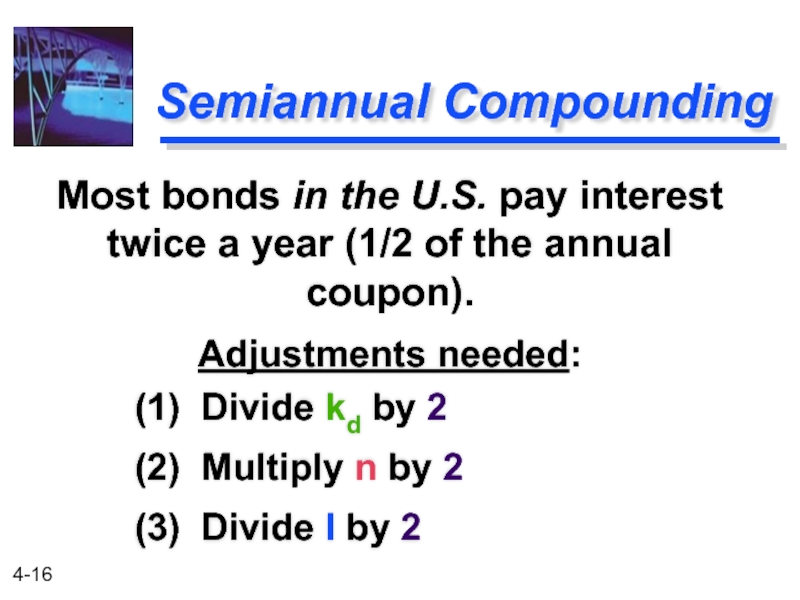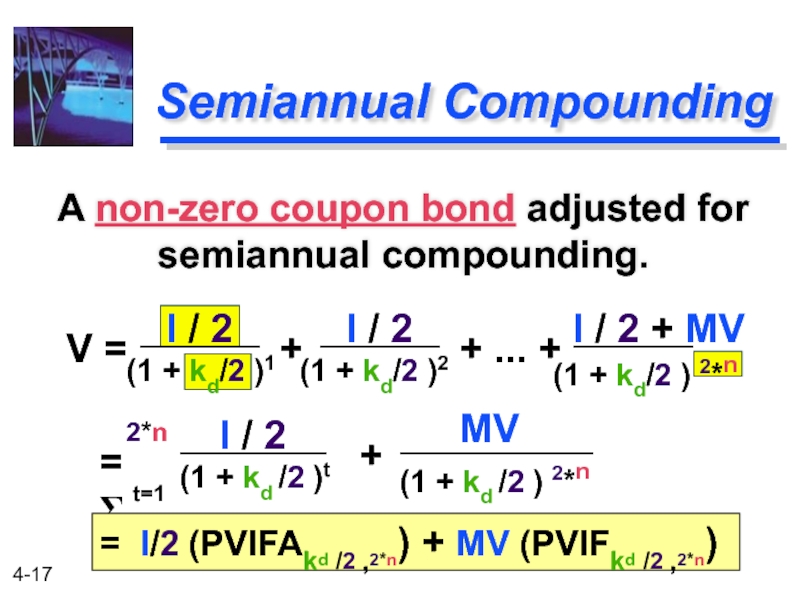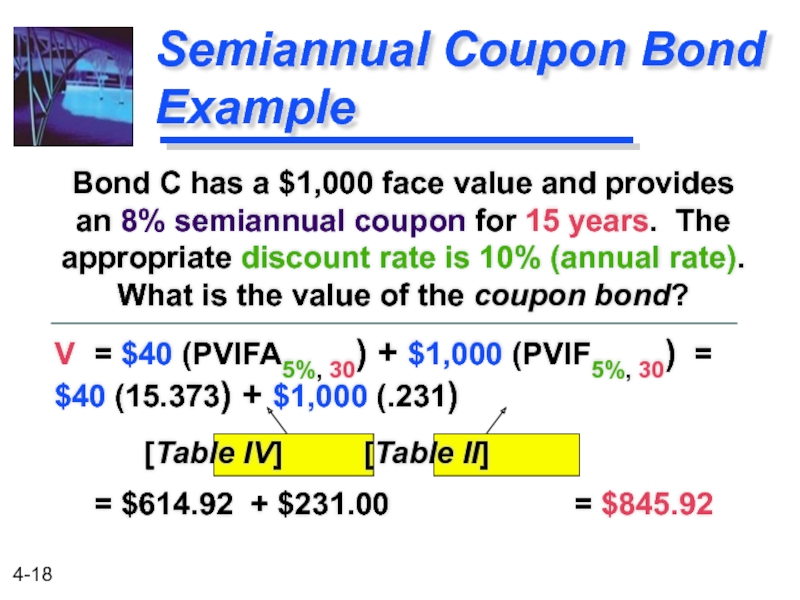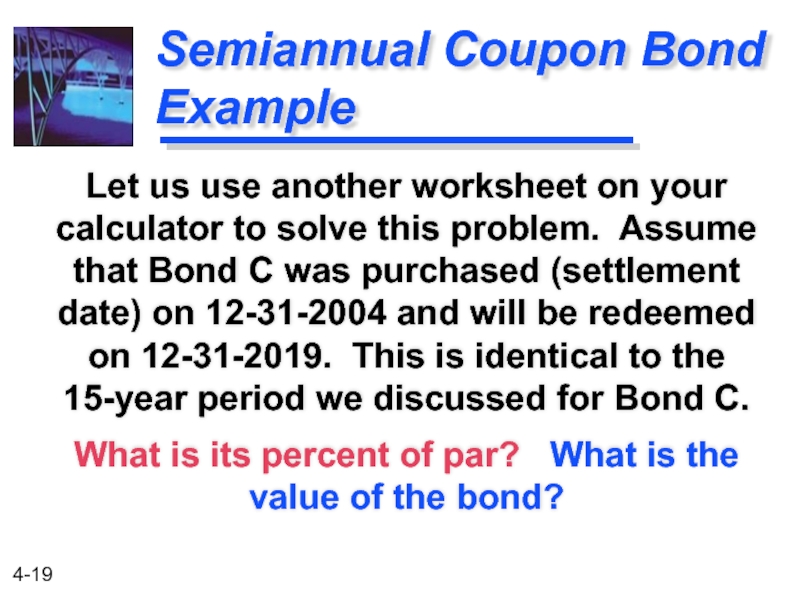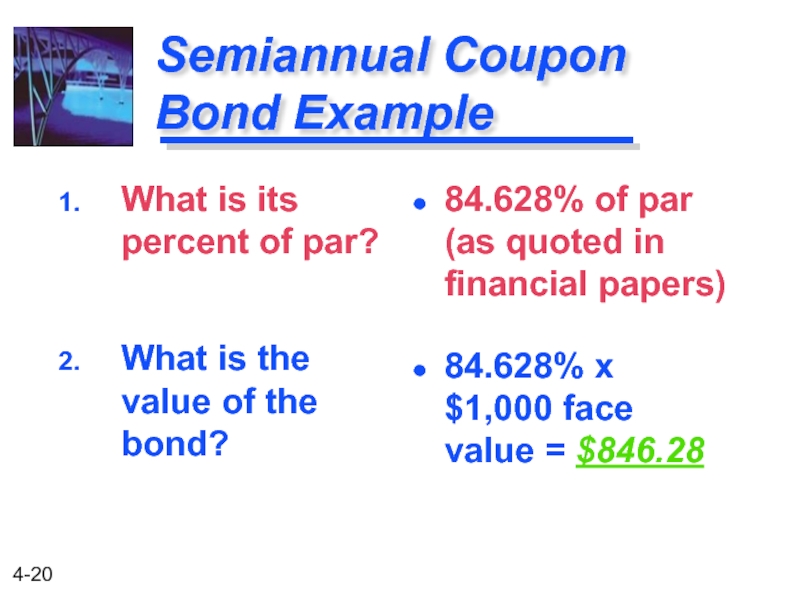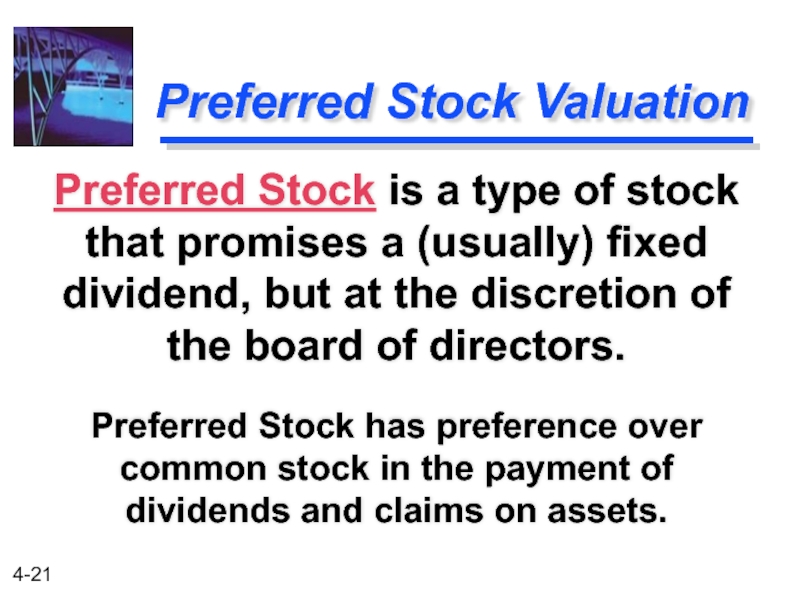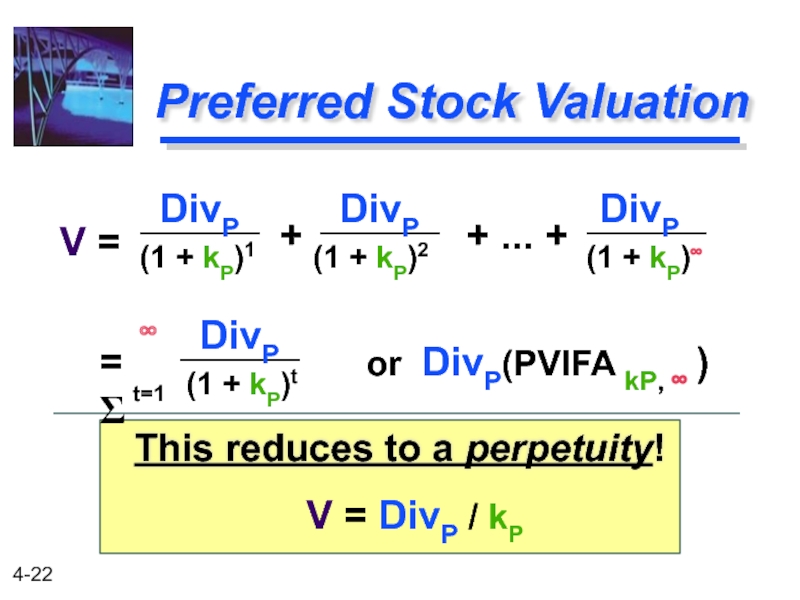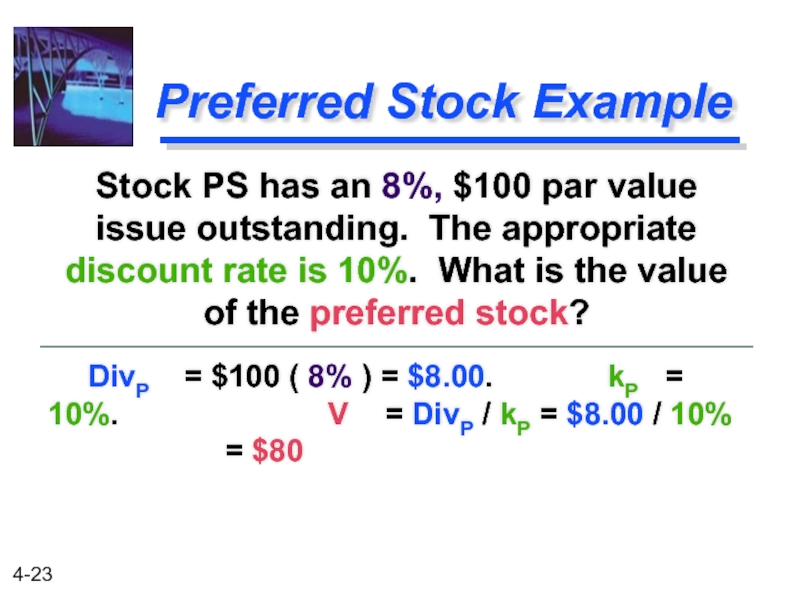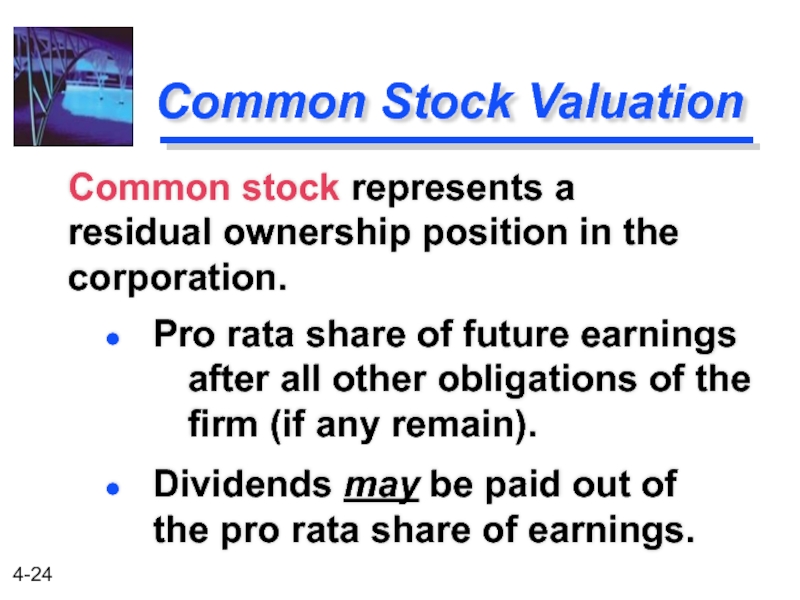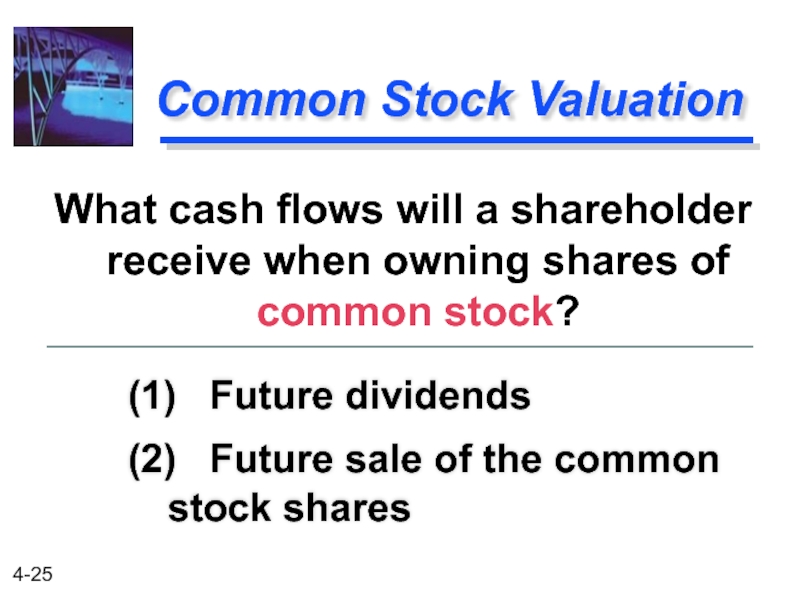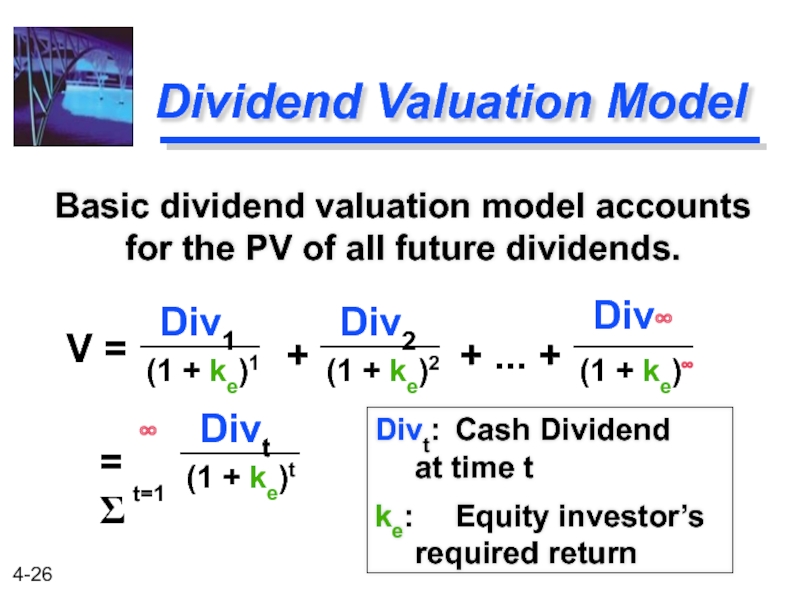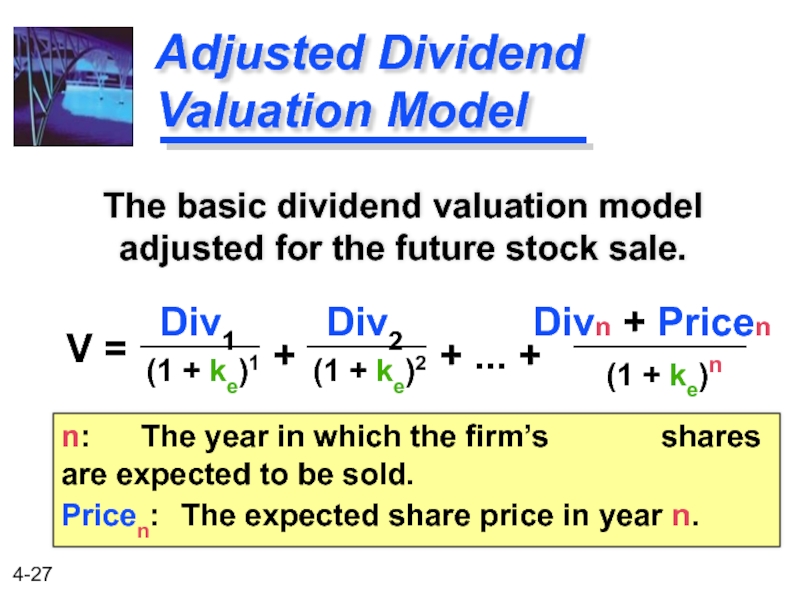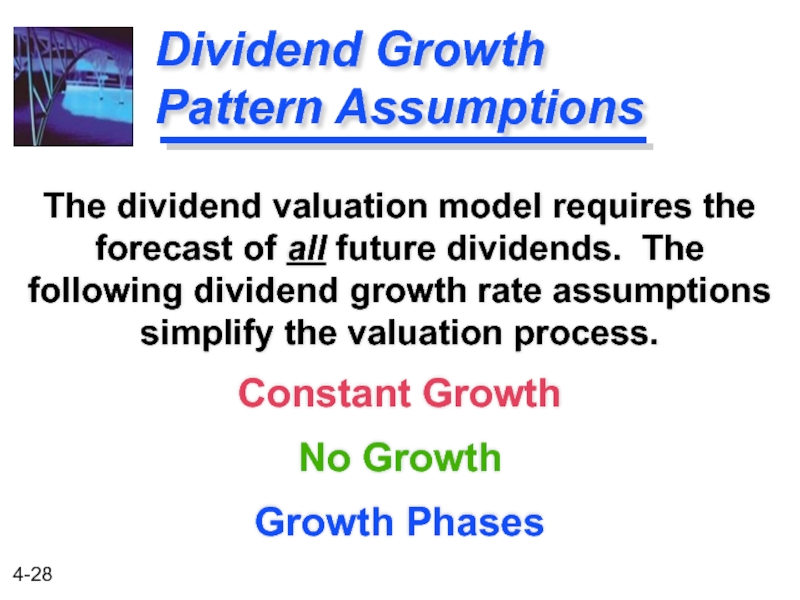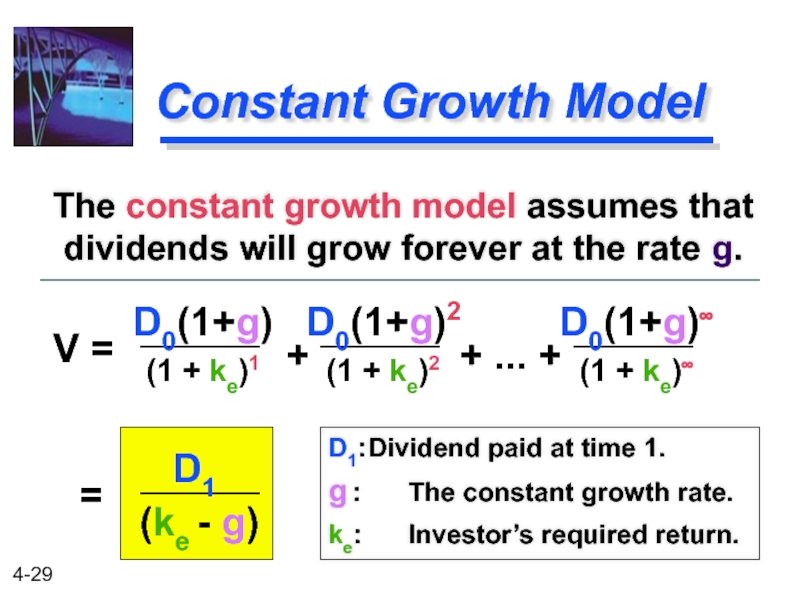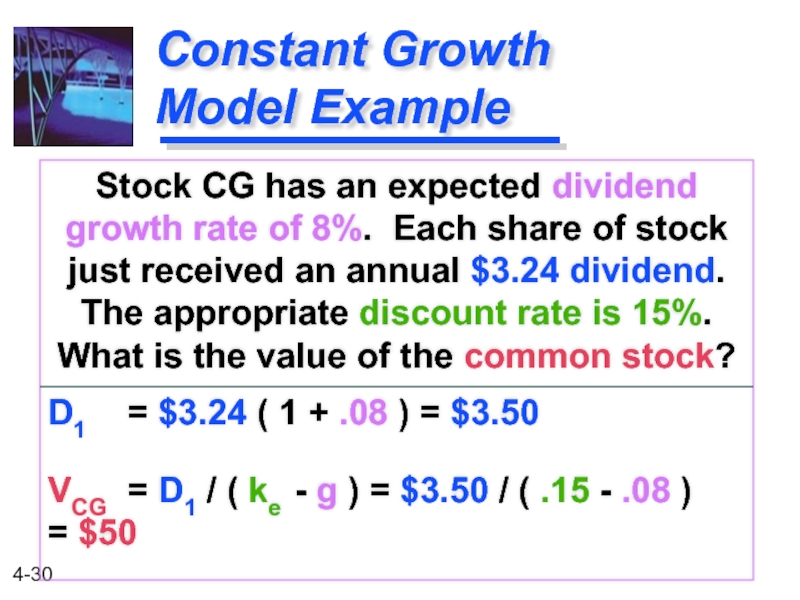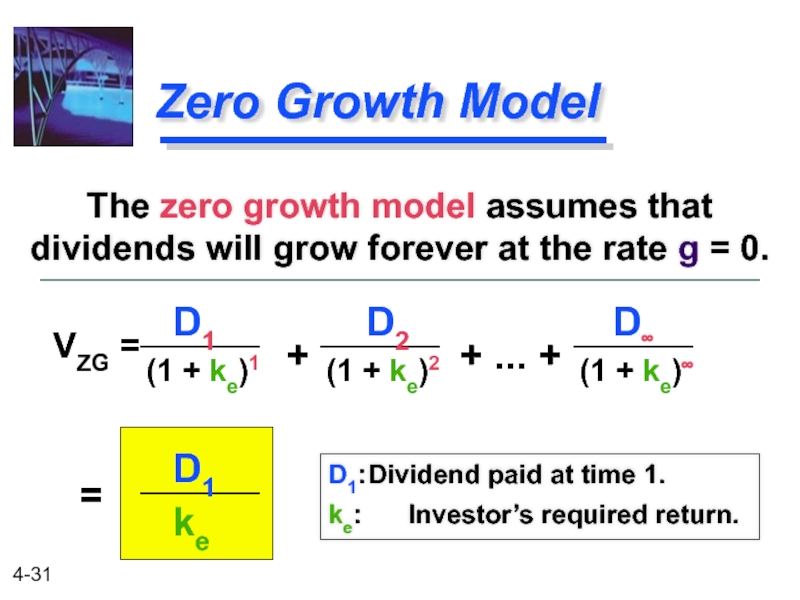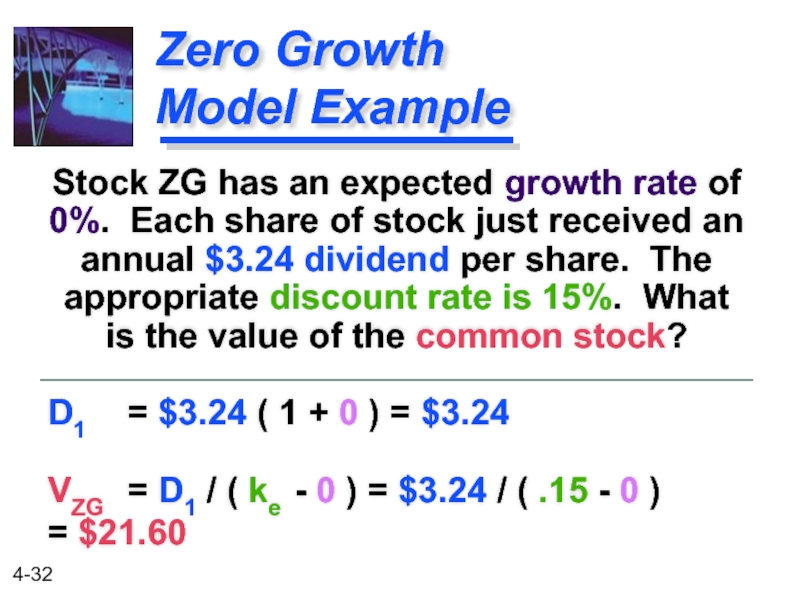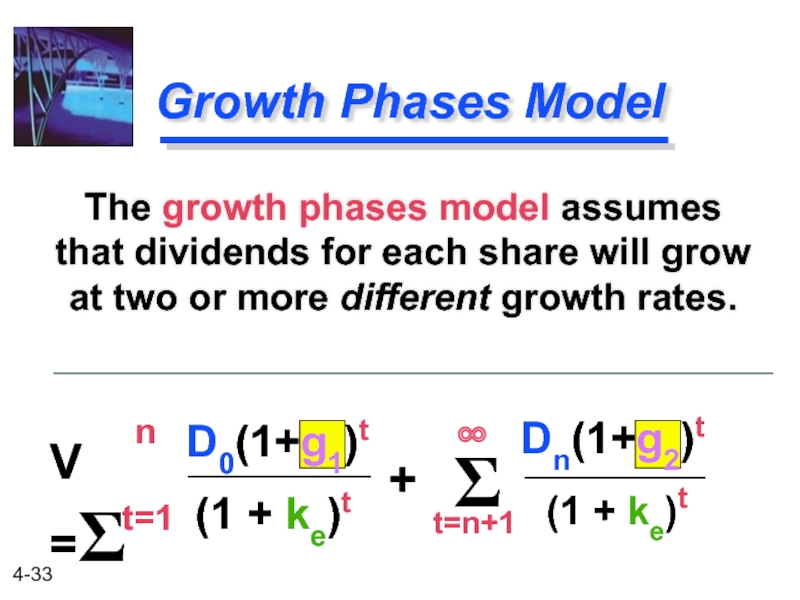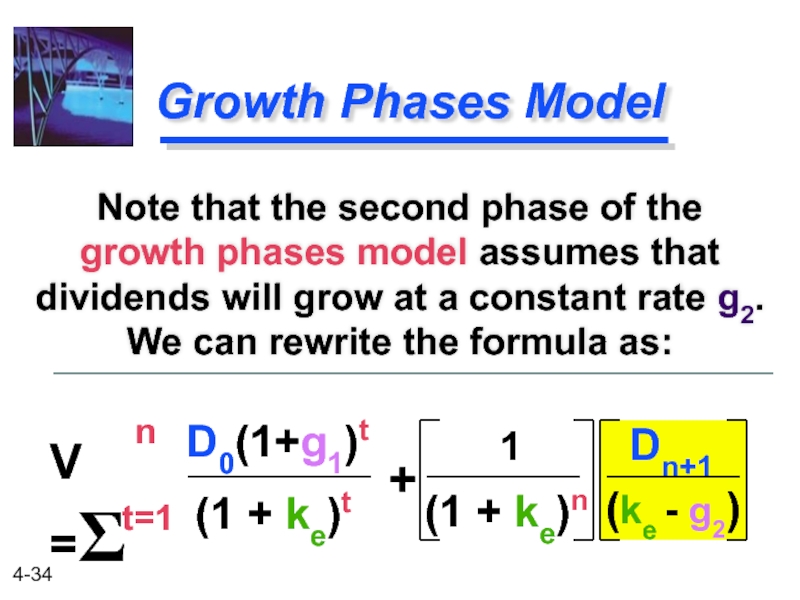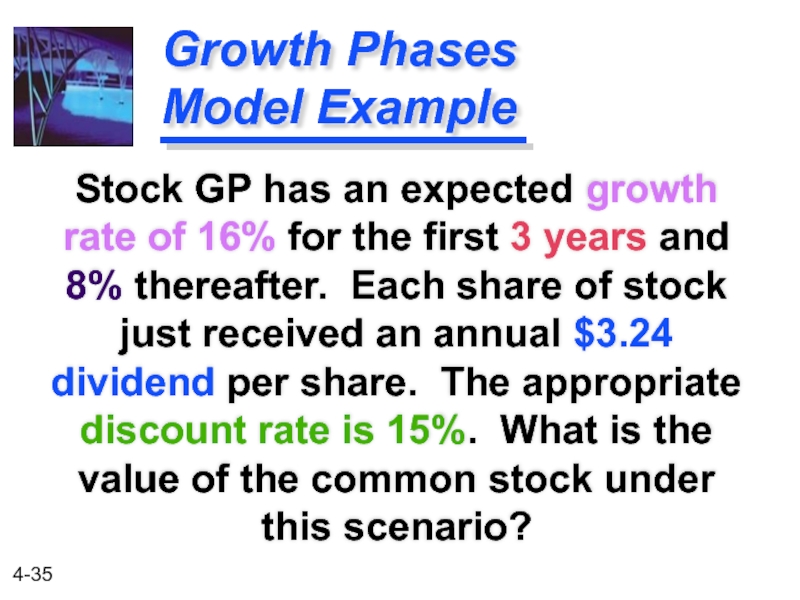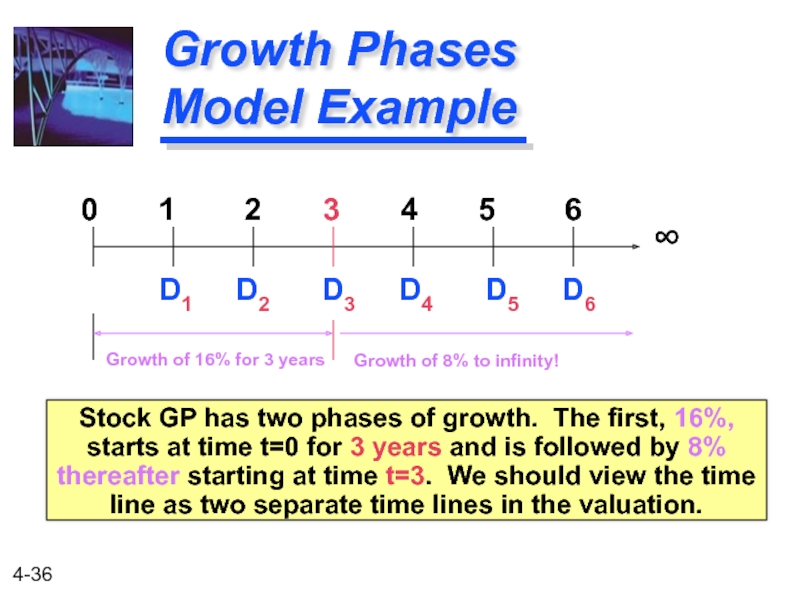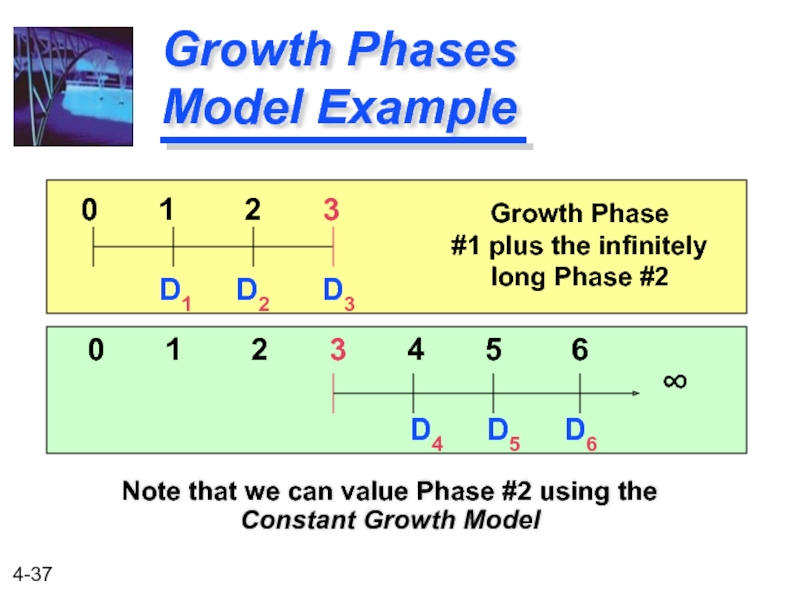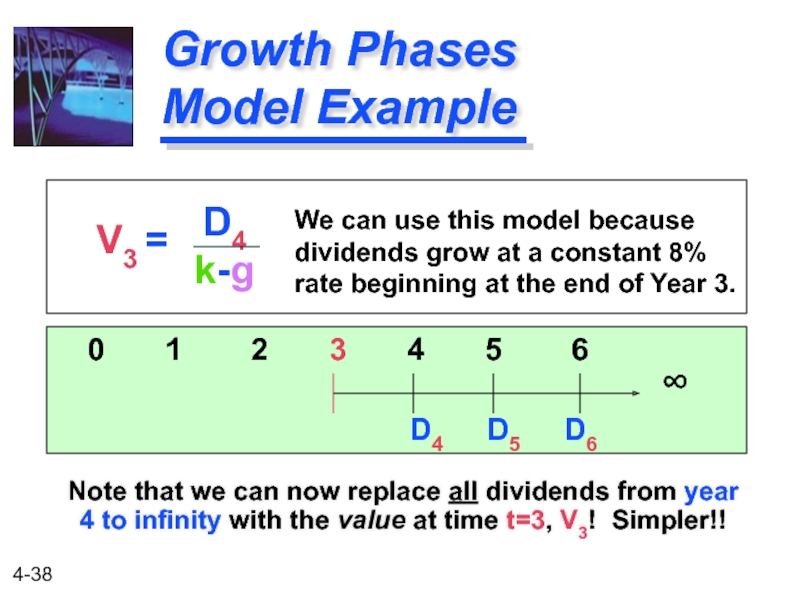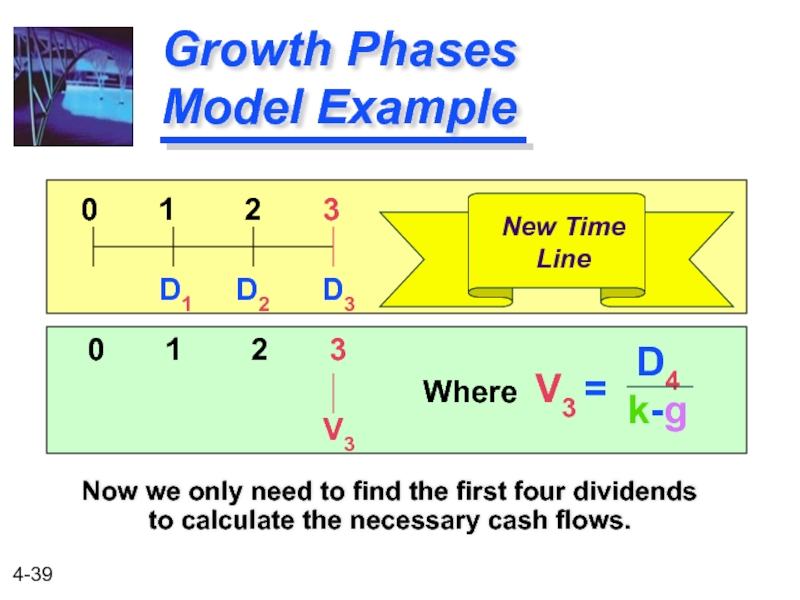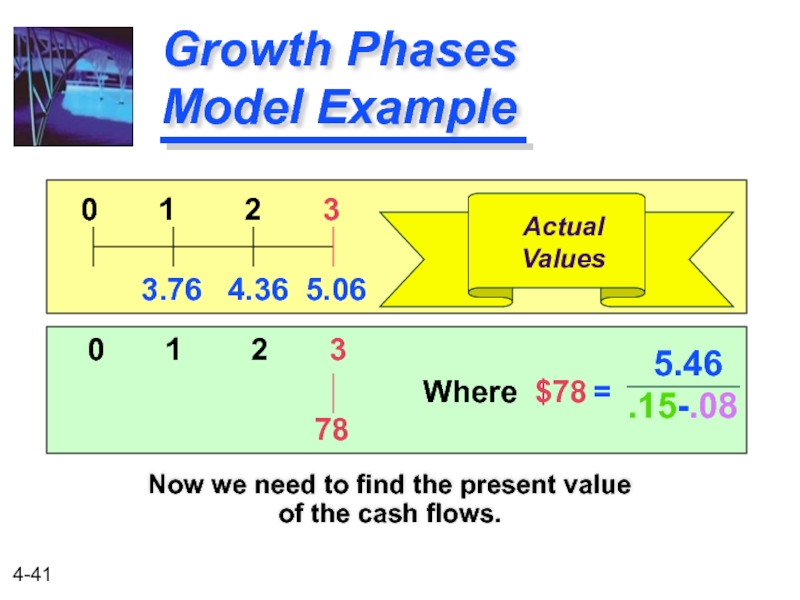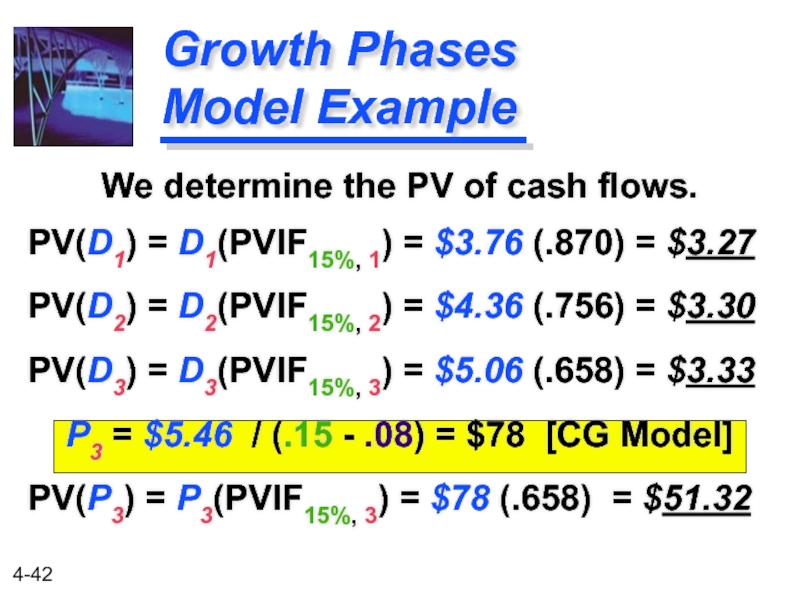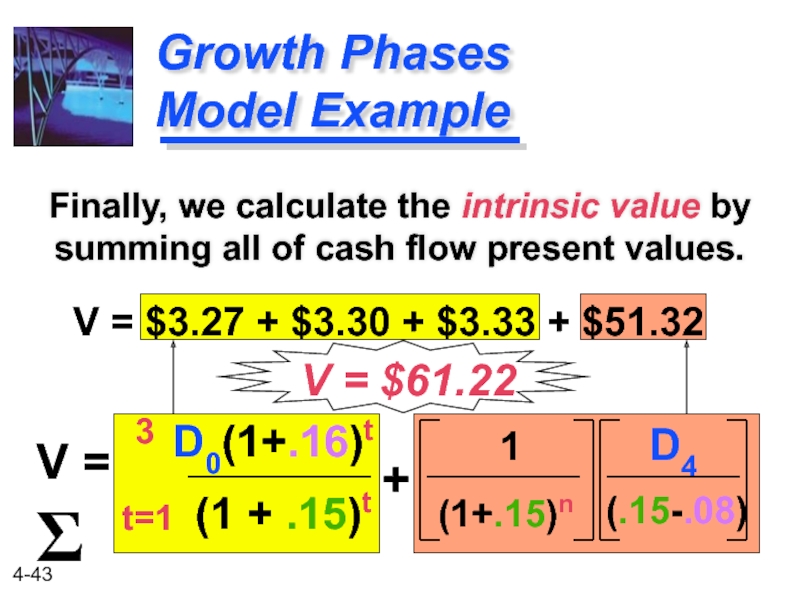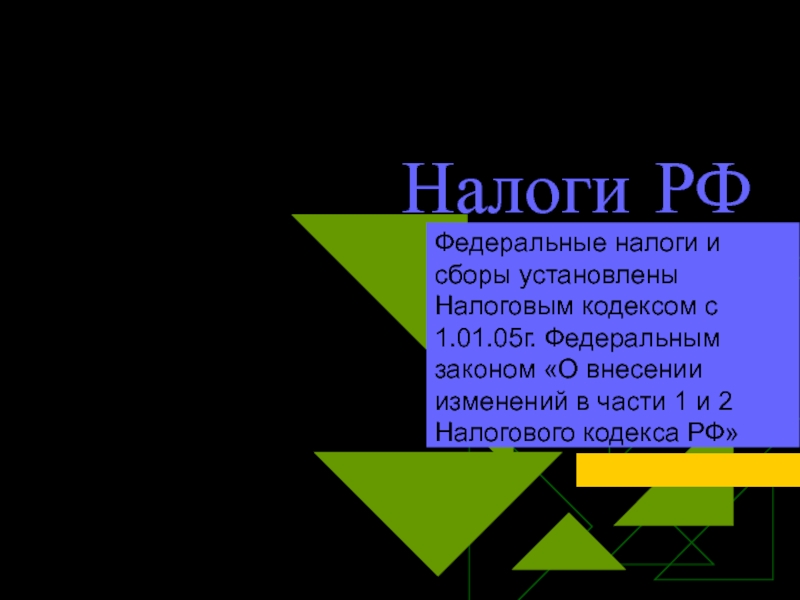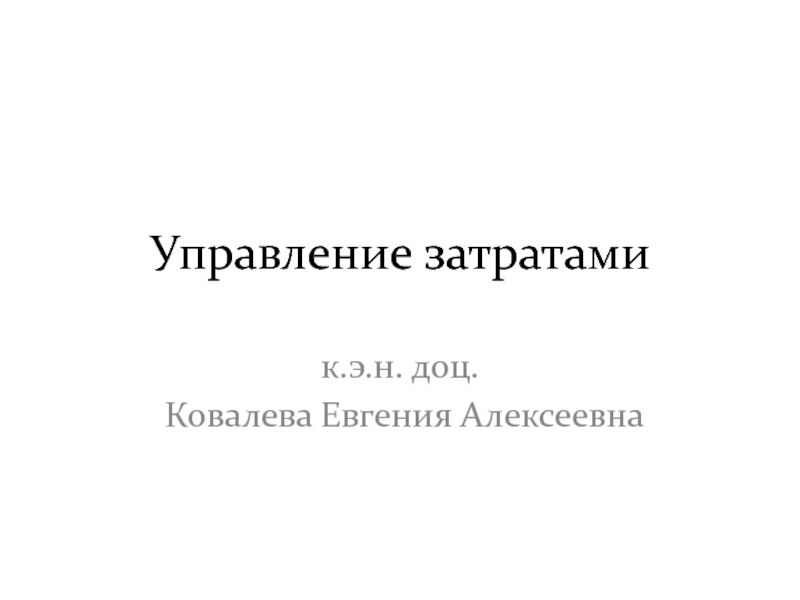- Главная
- Разное
- Дизайн
- Бизнес и предпринимательство
- Аналитика
- Образование
- Развлечения
- Красота и здоровье
- Финансы
- Государство
- Путешествия
- Спорт
- Недвижимость
- Армия
- Графика
- Культурология
- Еда и кулинария
- Лингвистика
- Английский язык
- Астрономия
- Алгебра
- Биология
- География
- Детские презентации
- Информатика
- История
- Литература
- Маркетинг
- Математика
- Медицина
- Менеджмент
- Музыка
- МХК
- Немецкий язык
- ОБЖ
- Обществознание
- Окружающий мир
- Педагогика
- Русский язык
- Технология
- Физика
- Философия
- Химия
- Шаблоны, картинки для презентаций
- Экология
- Экономика
- Юриспруденция
The Valuation of Long-Term Securities презентация
Содержание
- 1. The Valuation of Long-Term Securities
- 2. After studying Chapter 4, you should be
- 3. The Valuation of Long-Term Securities Distinctions
- 4. What is Value? Going-concern value represents the
- 5. What is Value? (2) a firm: total
- 6. What is Value? Intrinsic value represents the
- 7. Bond Valuation Important Terms Types of Bonds Valuation of Bonds Handling Semiannual Compounding
- 8. Important Bond Terms The maturity value (MV)
- 9. Important Bond Terms The discount rate (capitalization
- 10. Different Types of Bonds A
- 11. Perpetual Bond Example Bond P has a
- 12. Different Types of Bonds A non-zero
- 13. Bond C has a $1,000
- 14. Different Types of Bonds A zero
- 15. V = $1,000 (PVIF10%, 30) = $1,000 (.057) = $57.00
- 16. Semiannual Compounding (1) Divide kd by 2
- 17. (1 + kd/2 ) 2*n
- 18. V = $40 (PVIFA5%, 30) +
- 19. Semiannual Coupon Bond Example Let us use
- 20. Semiannual Coupon Bond Example What is its
- 21. Preferred Stock is a type of stock
- 22. Preferred Stock Valuation This reduces to
- 23. Preferred Stock Example DivP = $100
- 24. Common Stock Valuation Pro rata share of
- 25. Common Stock Valuation (1) Future dividends
- 26. Dividend Valuation Model Basic dividend valuation model
- 27. Adjusted Dividend Valuation Model The basic dividend
- 28. Dividend Growth Pattern Assumptions The dividend valuation
- 29. Constant Growth Model The constant growth
- 30. Constant Growth Model Example Stock CG has
- 31. Zero Growth Model The zero growth
- 32. Zero Growth Model Example Stock ZG
- 33. D0(1+g1)t Dn(1+g2)t Growth Phases Model
- 34. D0(1+g1)t Dn+1 Growth Phases Model Note
- 35. Growth Phases Model Example Stock GP has
- 36. Growth Phases Model Example Stock GP has
- 37. Growth Phases Model Example Note
- 38. Growth Phases Model Example Note
- 39. Growth Phases Model Example Now
- 40. Growth Phases Model Example Determine the annual
- 41. Growth Phases Model Example Now
- 42. Growth Phases Model Example We determine
- 43. D0(1+.16)t D4 Growth
Слайд 2After studying Chapter 4, you should be able to:
Distinguish among the
Value bonds, preferred stocks, and common stocks.
Calculate the rates of return (or yields) of different types of long-term securities.
List and explain a number of observations regarding the behavior of bond prices.
Слайд 3The Valuation of
Long-Term Securities
Distinctions Among Valuation Concepts
Bond Valuation
Preferred Stock Valuation
Common
Rates of Return (or Yields)
Слайд 4What is Value?
Going-concern value represents the amount a firm could be
Liquidation value represents the amount of money that could be realized if an asset or group of assets is sold separately from its operating organization.
Слайд 5What is Value?
(2) a firm: total assets minus liabilities and preferred
Book value represents either
(1) an asset: the accounting value of an asset -- the asset’s cost minus its accumulated depreciation;
Слайд 6What is Value?
Intrinsic value represents the price a security “ought to
Market value represents the market price at which an asset trades.
Слайд 8Important Bond Terms
The maturity value (MV) [or face value] of a
A bond is a long-term debt instrument issued by a corporation or government.
Слайд 9Important Bond Terms
The discount rate (capitalization rate) is dependent on the
The bond’s coupon rate is the stated rate of interest; the annual interest payment divided by the bond’s face value.
Слайд 10
Different Types of Bonds
A perpetual bond is a bond that never
(1 + kd)1
(1 + kd)2
(1 + kd)∞
V =
+
+ ... +
I
I
I
= Σ
∞
t=1
(1 + kd)t
I
or I (PVIFA kd, ∞ )
V = I / kd [Reduced Form]
Слайд 11Perpetual Bond Example
Bond P has a $1,000 face value and provides
I = $1,000 ( 8%) = $80.
kd = 10%.
V = I / kd [Reduced Form]
= $80 / 10% = $800.
Слайд 12
Different Types of Bonds
A non-zero coupon-paying bond is a coupon paying
(1 + kd)1
(1 + kd)2
(1 + kd)n
V =
+
+ ... +
I
I + MV
I
= Σ
n
t=1
(1 + kd)t
I
V = I (PVIFA kd, n) + MV (PVIF kd, n)
(1 + kd)n
+
MV
Слайд 13
Bond C has a $1,000 face value and provides an 8%
Coupon Bond Example
V = $80 (PVIFA10%, 30) + $1,000 (PVIF10%, 30) = $80 (9.427) + $1,000 (.057)
[Table IV] [Table II]
= $754.16 + $57.00 = $811.16.
Слайд 14
Different Types of Bonds
A zero coupon bond is a bond that
(1 + kd)n
V =
MV
= MV (PVIFkd, n)
Слайд 15 V = $1,000 (PVIF10%, 30) = $1,000 (.057) = $57.00
Zero-Coupon Bond Example
Bond Z has
Слайд 16Semiannual Compounding
(1) Divide kd by 2
(2) Multiply n by 2
(3) Divide
Most bonds in the U.S. pay interest twice a year (1/2 of the annual coupon).
Adjustments needed:
Слайд 17
(1 + kd/2 ) 2*n
(1 + kd/2 )1
Semiannual Compounding
A non-zero coupon
V =
+
+ ... +
I / 2
I / 2 + MV
= Σ
2*n
t=1
(1 + kd /2 )t
I / 2
= I/2 (PVIFAkd /2 ,2*n) + MV (PVIFkd /2 ,2*n)
(1 + kd /2 ) 2*n
+
MV
I / 2
(1 + kd/2 )2
Слайд 18
V = $40 (PVIFA5%, 30) + $1,000 (PVIF5%, 30) = $40 (15.373)
[Table IV] [Table II]
= $614.92 + $231.00 = $845.92
Semiannual Coupon Bond Example
Bond C has a $1,000 face value and provides an 8% semiannual coupon for 15 years. The appropriate discount rate is 10% (annual rate). What is the value of the coupon bond?
Слайд 19Semiannual Coupon Bond Example
Let us use another worksheet on your calculator
What is its percent of par? What is the value of the bond?
Слайд 20Semiannual Coupon Bond Example
What is its percent of par?
What is the
84.628% of par (as quoted in financial papers)
84.628% x $1,000 face value = $846.28
Слайд 21Preferred Stock is a type of stock that promises a (usually)
Preferred Stock Valuation
Preferred Stock has preference over common stock in the payment of dividends and claims on assets.
Слайд 22
Preferred Stock Valuation
This reduces to a perpetuity!
(1 + kP)1
(1 + kP)2
(1
V =
+
+ ... +
DivP
DivP
DivP
= Σ
∞
t=1
(1 + kP)t
DivP
or DivP(PVIFA kP, ∞ )
V = DivP / kP
Слайд 23Preferred Stock Example
DivP = $100 ( 8% ) = $8.00.
Stock PS has an 8%, $100 par value issue outstanding. The appropriate discount rate is 10%. What is the value of the preferred stock?
Слайд 24Common Stock Valuation
Pro rata share of future earnings after all other
Dividends may be paid out of the pro rata share of earnings.
Common stock represents a residual ownership position in the corporation.
Слайд 25Common Stock Valuation
(1) Future dividends
(2) Future sale of the
What cash flows will a shareholder receive when owning shares of common stock?
Слайд 26Dividend Valuation Model
Basic dividend valuation model accounts for the PV of
(1 + ke)1
(1 + ke)2
(1 + ke)∞
V =
+
+ ... +
Div1
Div∞
Div2
= Σ
∞
t=1
(1 + ke)t
Divt
Divt: Cash Dividend at time t
ke: Equity investor’s required return
Слайд 27Adjusted Dividend Valuation Model
The basic dividend valuation model adjusted for the
(1 + ke)1
(1 + ke)2
(1 + ke)n
V =
+
+ ... +
Div1
Divn + Pricen
Div2
n: The year in which the firm’s shares are expected to be sold.
Pricen: The expected share price in year n.
Слайд 28Dividend Growth Pattern Assumptions
The dividend valuation model requires the forecast of
Constant Growth
No Growth
Growth Phases
Слайд 29
Constant Growth Model
The constant growth model assumes that dividends will grow
(1 + ke)1
(1 + ke)2
(1 + ke)∞
V =
+
+ ... +
D0(1+g)
D0(1+g)∞
=
(ke - g)
D1
D1: Dividend paid at time 1.
g : The constant growth rate.
ke: Investor’s required return.
D0(1+g)2
Слайд 30Constant Growth Model Example
Stock CG has an expected dividend growth rate
D1 = $3.24 ( 1 + .08 ) = $3.50
VCG = D1 / ( ke - g ) = $3.50 / ( .15 - .08 ) = $50
Слайд 31
Zero Growth Model
The zero growth model assumes that dividends will grow
(1 + ke)1
(1 + ke)2
(1 + ke)∞
VZG =
+
+ ... +
D1
D∞
=
ke
D1
D1: Dividend paid at time 1.
ke: Investor’s required return.
D2
Слайд 32Zero Growth
Model Example
Stock ZG has an expected growth rate of
D1 = $3.24 ( 1 + 0 ) = $3.24
VZG = D1 / ( ke - 0 ) = $3.24 / ( .15 - 0 ) = $21.60
Слайд 33
D0(1+g1)t
Dn(1+g2)t
Growth Phases Model
The growth phases model assumes that dividends for each
(1 + ke)t
(1 + ke)t
V =Σ
t=1
n
Σ
t=n+1
∞
+
Слайд 34
D0(1+g1)t
Dn+1
Growth Phases Model
Note that the second phase of the growth phases
(1 + ke)t
(ke - g2)
V =Σ
t=1
n
+
1
(1 + ke)n
Слайд 35Growth Phases Model Example
Stock GP has an expected growth rate of
Слайд 36Growth Phases Model Example
Stock GP has two phases of growth. The
∞
0 1 2 3 4 5 6
D1 D2 D3 D4 D5 D6
Growth of 16% for 3 years
Growth of 8% to infinity!
Слайд 37
Growth Phases Model Example
Note that we can value Phase #2 using
∞
0 1 2 3
D1 D2 D3
D4 D5 D6
0 1 2 3 4 5 6
Growth Phase
#1 plus the infinitely long Phase #2
Слайд 38
Growth Phases Model Example
Note that we can now replace all dividends
∞
V3 =
D4 D5 D6
0 1 2 3 4 5 6
D4
k-g
We can use this model because
dividends grow at a constant 8%
rate beginning at the end of Year 3.
Слайд 39
Growth Phases Model Example
Now we only need to find the first
0 1 2 3
D1 D2 D3
V3
0 1 2 3
New Time
Line
D4
k-g
Where V3 =
Слайд 40Growth Phases Model Example
Determine the annual dividends.
D0 = $3.24
D1 = D0(1+g1)1 = $3.24(1.16)1 =$3.76
D2 = D0(1+g1)2 = $3.24(1.16)2 =$4.36
D3 = D0(1+g1)3 = $3.24(1.16)3 =$5.06
D4 = D3(1+g2)1 = $5.06(1.08)1 =$5.46
Слайд 41
Growth Phases Model Example
Now we need to find the present value
0 1 2 3
3.76 4.36 5.06
78
0 1 2 3
Actual
Values
5.46
.15-.08
Where $78 =
Слайд 42
Growth Phases Model Example
We determine the PV of cash flows.
PV(D1) =
PV(D2) = D2(PVIF15%, 2) = $4.36 (.756) = $3.30
PV(D3) = D3(PVIF15%, 3) = $5.06 (.658) = $3.33
P3 = $5.46 / (.15 - .08) = $78 [CG Model]
PV(P3) = P3(PVIF15%, 3) = $78 (.658) = $51.32
Слайд 43
D0(1+.16)t
D4
Growth Phases
Model Example
Finally, we calculate the intrinsic value by summing
(1 + .15)t
(.15-.08)
V = Σ
t=1
3
+
1
(1+.15)n
V = $3.27 + $3.30 + $3.33 + $51.32
V = $61.22
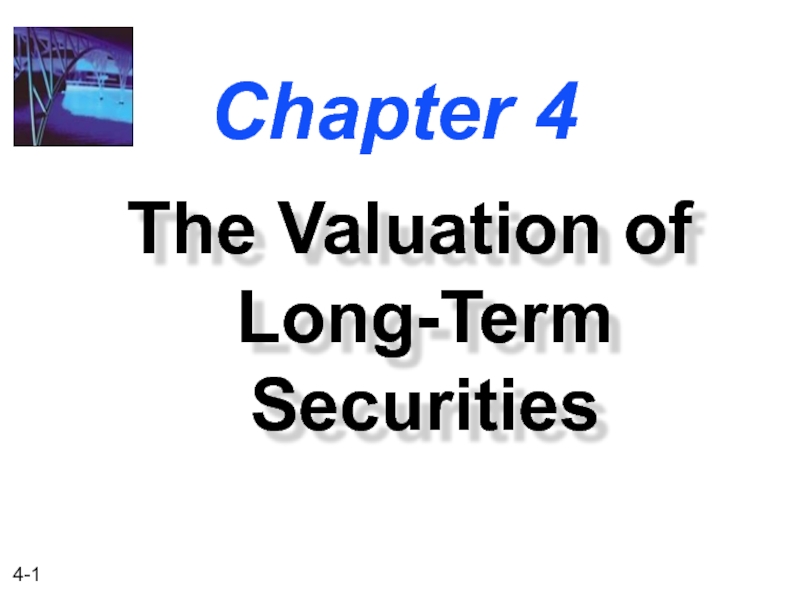
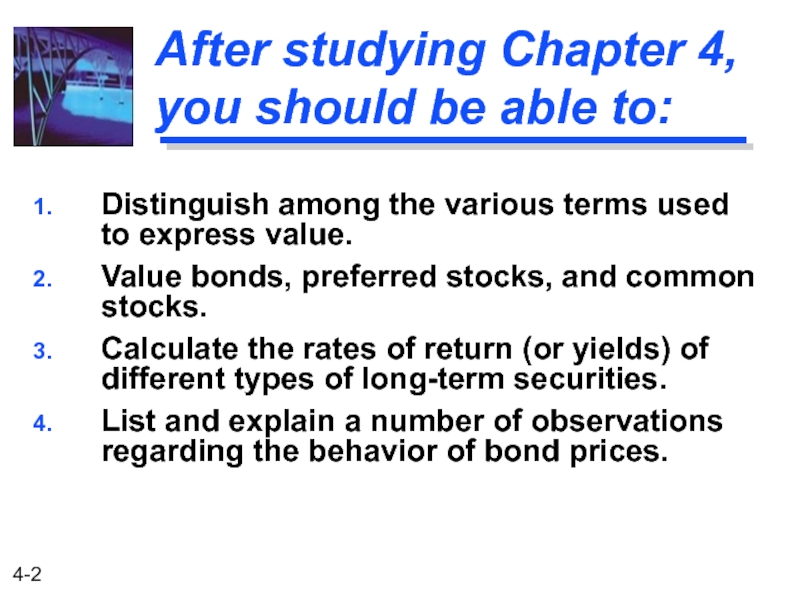
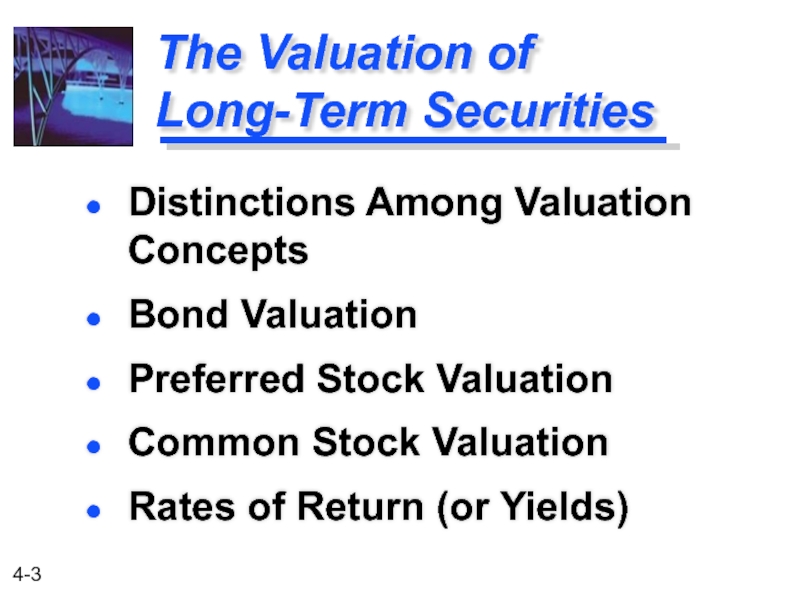
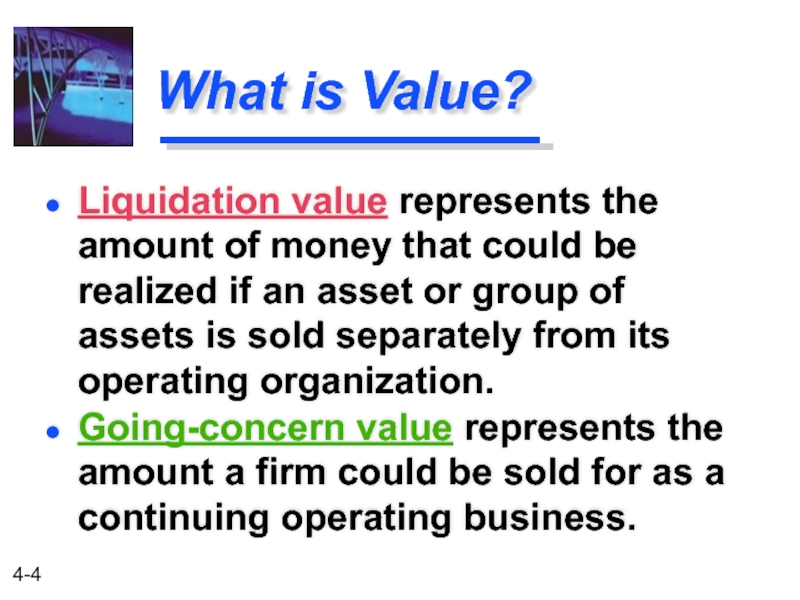
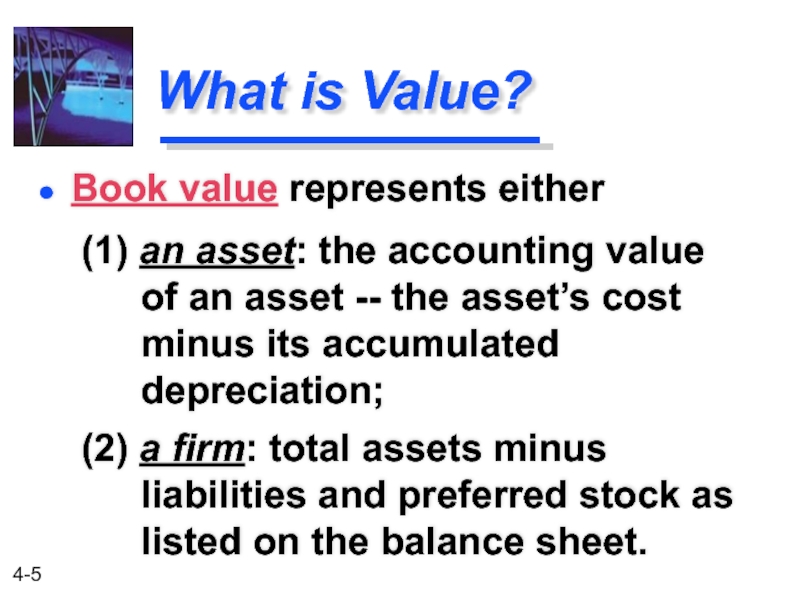
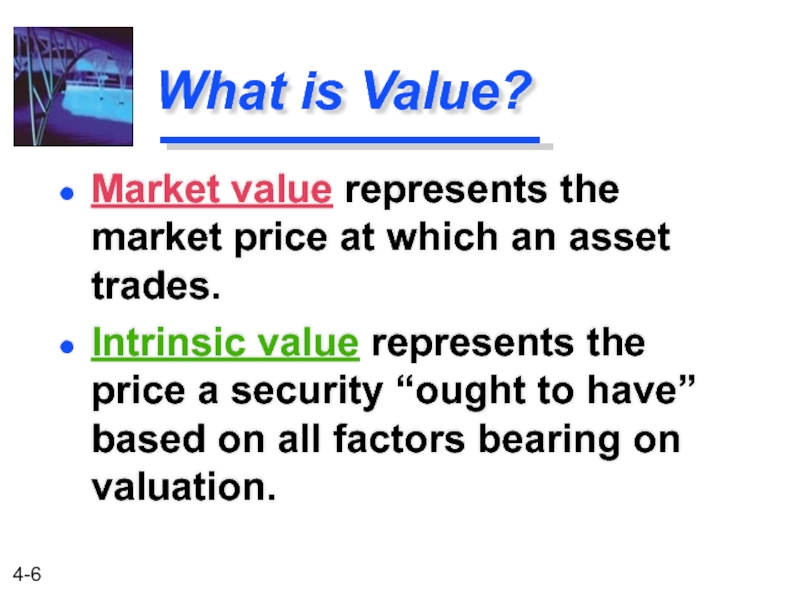
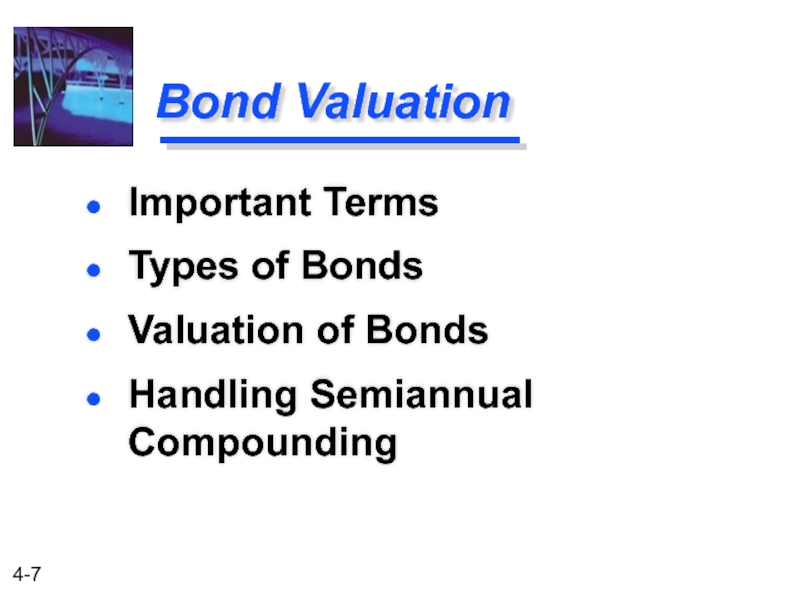
![Important Bond TermsThe maturity value (MV) [or face value] of a bond is the stated](/img/tmb/5/448143/8f61b9fd8d7112349c65495e02e1ac89-800x.jpg)
